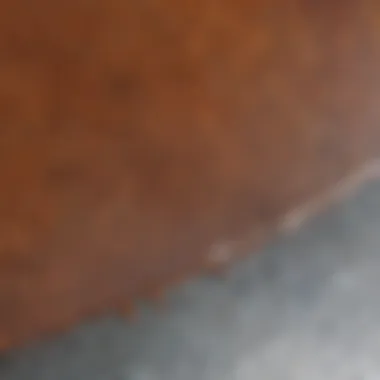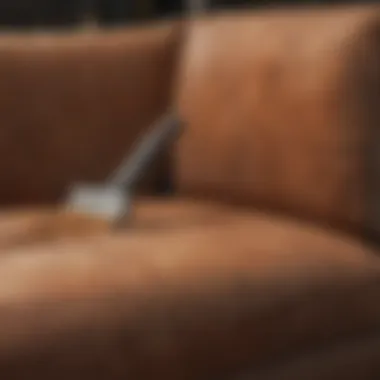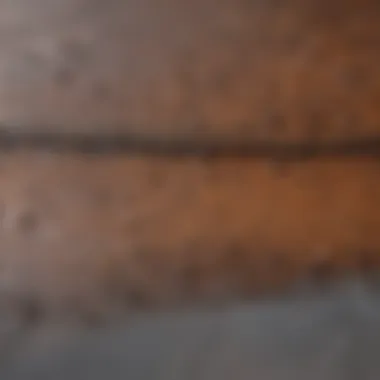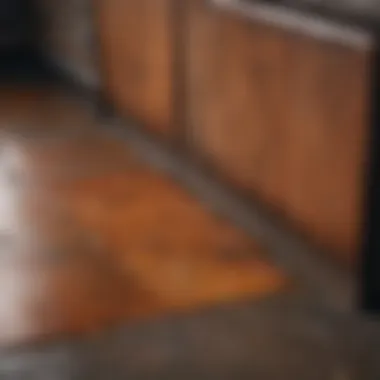Effective Methods for Rust Water Stain Removal


Intro
Rust water stains present a significant challenge in maintaining the aesthetic appeal of any environment, whether at home or in commercial spaces. Understanding the nature of these stains is crucial for effective removal. Rust stains originate from the oxidation of iron, commonly found in metal fixtures, pipes, and even water sources. When water containing dissolved iron evaporates, it leaves behind reddish-brown discoloration that can mar surfaces.
Recognizing the urgency of tackling these stains, this guide aims to furnish readers with practical solutions tailored for various surfaces. We aim to provide homeowners, renters, and professionals with a resource rich in methods and preventative strategies for effectively managing rust water stains. This article will explore approaches for removing stains from metal, fabric, and hard surfaces, while also discussing ways to maintain cleanliness post-removal. Understanding rust stains is undoubtedly the first step towards effective management.
Understanding Rust Water Stains
Rust water stains present a common yet troublesome issue for many homeowners and property managers. Understanding rust water stains is crucial for devising effective removal strategies. Not only do these stains impact the visual aesthetics of surfaces, but they can also reflect underlying issues in plumbing or outdoor maintenance. Therefore, a clear comprehension of what causes these stains and their common sources is essential.
Rust stains typically form when iron or metal comes into contact with water and air over time, leading to oxidation. This process leaves behind characteristic reddish-brown marks. Knowing this allows individuals to pinpoint problem areas in their homes or commercial spaces, potentially preventing future occurrences. Being informed also supports the selection of appropriate cleaning methods.
Importance of Addressing Rust Stains
Addressing rust stains in a timely manner is not just about enhancing appearance. Ignoring them can lead to further deterioration of materials, which may escalate to costly repairs or replacements. Thus, understanding rust water stains is the first step toward ensuring the long-term integrity of the affected surfaces. Being proactive not only saves effort in the long run but also helps maintain property value.
"Recognizing the formation mechanisms behind rust stains empowers homeowners to outsmart them effectively."
Actively engaging with the rust stain problem fosters awareness of various preventative strategies and maintenance routines. Awareness leads to action, ensuring that these unsightly marks are dealt with promptly and effectively. This guide, therefore, emphasizes that a solid grasp of rust water stain dynamics is a key element in preserving cleanliness and aesthetic appeal in both residential and commercial spaces.
What Causes Rust Stains
To comprehend rust stains thoroughly, it helps to look at their origins. Rust stains develop when iron oxides are generated through moisture exposure. Conditions that encourage this process include high humidity, stagnant water, or even contact with certain metallic elements. When moisture interacts with iron, it sets off a chemical reaction which produces rust.
In addition, rust stains may appear more rapidly due to acidic elements in water, such as iron-rich well water or water with a low pH. These factors accelerate the oxidation process, which amplifies the staining phenomena. Therefore, understanding these caustic conditions is vital for anyone aiming to manage the incidence of rust stains effectively.
Common Sources of Rust Stains
Several everyday sources contribute to the emergence of rust stains, including:
- Metal fixtures: Tap fixtures, railings, and other metal components can leak and cause staining when moisture collects.
- Outdoor equipment: Lawn mowers and gardening tools made of metal are prone to rust. Their use without proper drying can lead to contact with surfaces, resulting in stains.
- Water appliances: Washing machines and dishwashers can be culprits if metal parts corrode internally.
- Landscaping runoff: Water from garden hoses or sprinkler systems can carry rust particles onto other surfaces, creating stains.
- Construction materials: Rust can leach from iron or steel within concrete or metal frames, making their way to visible surfaces, leading to unsightly marks.
By identifying these common sources, property owners can take proactive measures to mitigate the risk of rust stains. Regular inspections and maintenance routines are fundamental in safeguarding against damage caused by rust water stains.
Identifying Different Types of Surfaces Affected by Rust Stains
Identifying the types of surfaces affected by rust stains is crucial in the cleaning process. Different materials interact uniquely with rust, determining the approach for effective removal. Understanding these differences can influence the choice of cleaning agents, methods, and maintenance practices. This is especially vital for homeowners and maintenance professionals aiming to preserve the aesthetic and functional aspects of affected surfaces.
Metal Surfaces
Metal surfaces are the primary victims of rust stains, particularly in environments exposed to moisture. Stainless steel, iron, and aluminum all show susceptibility to rust, although they respond differently to treatment. Ensuring proper identification of the metal type is essential. For instance, while stainless steel can withstand some harsh cleaning agents, iron can corrode further if not treated correctly.
To clean rust from metal:
- Use specialized rust removers for safe application.
- Avoid abrasive scrubbers which can scratch the surface.
- Consider applying a protective seal after cleaning to prevent future rust formation.
Regular maintenance checks can help in identifying early signs of rust, allowing for timely intervention.
Fabric and Upholstery
Rust stains on fabric and upholstery can be particularly challenging. These stains often occur when metal objects come into contact with damp fabrics or during furniture rust from legs. The fibers' sensitivity to chemicals requires careful selection of cleaning agents. Test any cleaner on a hidden area first to prevent damage.
For fabric treatments, consider the following:
- Blot the stain immediately with a clean cloth to absorb excess moisture.
- Use a fabric-safe rust remover or white vinegar, applying it gently.
- Always rinse thoroughly, as residue can attract more dirt.
Understanding the fabric type will help determine the safest and most effective cleaning approach.


Hard Surfaces (Tiles, Concrete, etc.)
Hard surfaces such as tiles and concrete can also bear the brunt of rust stains, especially in outdoor settings. These surfaces are porous and may absorb rust, making it tougher to eliminate. Identifying the type of hard surface is key, as it affects the cleaning method.
For hard surfaces:
- Cleaners containing phosphoric acid can be effective but test in an inconspicuous area first.
- For non-porous tiles, a mixture of baking soda and water can help lift stains without severe scrubbing.
- Concrete may require more intensive scrubbing if stains penetrate deeply. A pressure washer can assist in certain circumstances.
It's crucial to address rust stains quickly on hard surfaces to prevent permanent discoloration. Understanding the material ensures you choose an effective cleaner tailored to the surface's unique properties.
Effective Methods for Rust Stain Removal
Rust stains can be particularly stubborn, and the methods for their removal vary significantly based on factors such as surface type and the severity of the stain. Understanding effective methods is crucial for ensuring successful cleaning outcomes. This section explores several strategies, providing insights into their effectiveness and application.
Chemical Cleaners
Chemical cleaners are commonly used for removing rust stains due to their efficiency and fast action. These products are formulated specifically to target the iron oxide that causes rust stains. They often contain ingredients like phosphoric acid, oxalic acid, or citric acid. When applied, they penetrate the rust compounds, breaking them down to lift stains from surfaces.
Benefits of Chemical Cleaners:
- Speed: They typically work quickly, allowing for reduced cleaning time.
- Effectiveness: They can remove tough stains that might resist other methods.
- Versatility: Many cleaners are suitable for multiple surfaces, making them multifunctional.
However, caution is necessary when using chemical cleaners. It's imperative to read the instructions and safety precautions closely to avoid damage to surfaces or risk to health. For example, products like Iron-Out or CLR are effective on various materials, but they may not be suitable for all types of fabric or painted surfaces.
Natural Alternatives
For those concerned about the environmental impact of chemicals or looking for safer options, natural alternatives can be effective against rust stains. Common household items can often serve as powerful rust removers.
- Vinegar: Acetic acid in vinegar dissolves rust and can be used for minor stains. Simply apply it to the stain, let it sit for a while, then scrub gently.
- Baking Soda: This can be mixed with water to create a paste. It provides a mild abrasive quality that is helpful for scrubbing away rust without scratching the surface.
- Lemon Juice and Salt: This combination is a classic natural cleaner. The acidity of the lemon and the abrasiveness of the salt can lift stains effectively.
Natural alternatives are generally safer for the environment and can be utilized regularly without the health risks associated with some chemical products. They are also cost-effective, using items that are often already found at home.
Mechanical Methods
When chemical and natural methods are ineffective, mechanical methods should be considered. These involve the physical removal of rust stains through scrubbing or abrasion.
- Scrubbing with Brushes: Nylon or bristle brushes are often used for tougher stains on hard surfaces. They provide the necessary friction to lift away rust.
- Sandpaper: When rust is particularly stubborn, light sanding can help. Care should be taken to avoid damaging delicate surfaces.
- Pressure Washers: For outdoor surfaces, pressure washers can be very effective. They apply high-pressure water to strip away rust and debris.
While mechanical methods can be effective, they carry a risk of damaging delicate materials. Therefore, using them appropriately and judiciously is important. Always start with the least abrasive option to minimize surface damage.
Important Note: Always test cleaner solutions on a small, inconspicuous area before proceeding with the entire surface. This can prevent potential damage to the material being cleaned.
Step-by-Step Rust Stain Removal Process
The process of removing rust stains systematically is crucial for both effective cleaning and long-term surface care. Understanding the steps involved ensures that homeowners and enthusiasts can tackle rust stains without causing additional damage. Furthermore, a structured approach minimizes frustration, maximizes efficiency, and enhances the end result. This section will guide the reader through preparation, application of cleaning solutions, and proper rinsing techniques.
Preparation and Safety Precautions
Before embarking on the removal of rust stains, proper preparation is vital. Here are key steps to consider:
- Assess the Surface: Identify the material type to avoid damaging it.
- Gather Supplies: Common tools include sponges, brushes, old towels, and protective gear.
- Wear Protective Gear: Gloves, masks, and eye protection are necessary when using chemical cleaners. This will reduce exposure to harsh chemicals or rust particles.
By ensuring these preparatory steps are taken, one can create a safer working environment and improve the chances of successful stain removal.
Applying Cleaning Solutions
The application of cleaning solutions is the most critical step. Here, one must choose between chemical and natural alternatives tailored to the surface type.
- Chemical Cleaners: Apply the cleaner according to the manufacturer’s instructions. It is advisable to test in a small area first.
- Natural Alternatives: For those preferring less harsh solutions, mixtures like vinegar and baking soda can be effective. Simply apply the mixture directly on the stained area.
- Technique: Use a sponge or brush to scrub the area gently. Avoid excessive force to prevent surface damage.


This step needs patience and attention to detail. Ensuring thorough contact with the stain can yield better results.
Rinsing and Drying
The final phase of rust stain removal involves rinsing and drying the treated area effectively to remove any remnants of cleaning solutions. Here's how:
- Rinse Thoroughly: Use clean water to wash away cleaning agents. Ensure all residue is gone, as leftover chemicals can lead to further staining or damage.
- Dry Completely: Pat the area dry with a clean towel or allow air drying. For sensitive surfaces, use a fan or air blower to ensure moisture doesn’t linger.
Proper rinsing and drying not only finalize the cleaning process but also contribute to the prevention of future rust stains. Maintaining attention to detail during these steps will enhance the overall appearance of the surface and ensure a cleaner and more robust finish.
Prevention of Rust Stains
Preventing rust stains is crucial for maintaining the aesthetic and structural integrity of various surfaces in both residential and commercial settings. Rust stains, once established, can be persistent and challenging to remove. The costs involved in remedial actions, both monetary and in terms of time, can be significant. By focusing on prevention, one can avoid the hassle of extensive cleaning or repairs down the line.
Selecting Rust-Resistant Materials
Choosing materials that resist rust is the first line of defense against rust stains. This is important in environments where moisture may be prevalent, such as kitchens, bathrooms, and outdoor areas. When selecting items like fixtures or outdoor furniture, consider options made from stainless steel, aluminum, or treated wood. These materials do not rust easily and offer longevity in their application. Here are some notable choices to consider:
- Stainless Steel: Corrosion resistant and durable, excellent for sinks and appliances.
- Aluminum: Lightweight and resistant to rust, suitable for outdoor furniture.
- Galvanized Steel: Coated with a layer of zinc, providing a protective barrier against rust.
Using these materials can significantly reduce the risks associated with rust stains.
Regular Maintenance Practices
Routine cleaning and maintenance help prevent rust stains from developing. It is beneficial to implement a schedule for inspecting and cleaning surfaces that are particularly prone to rust. Here are several practices to consider:
- Frequent Cleaning: Regularly clean surfaces to remove dirt, debris, and moisture that can encourage rust formation.
- Sealants: Apply protective sealants on concrete or metal surfaces. This can help create a barrier against water and contaminants.
- Proper Drainage: Ensure that water can drain away easily from surfaces to prevent pooling, a common cause of rust.
"An ounce of prevention is worth a pound of cure." Implementing these simple practices can save time and resources in the long term.
Impact of Rust Stains on Aesthetic Appeal
Rust stains can significantly affect the visual appeal of both residential and commercial spaces. These stains often appear as unsightly blemishes on surfaces ranging from metal to fabric. Understanding their impact is crucial for maintaining an inviting environment. Moreover, rust stains can detract from the intended aesthetic, creating a sense of neglect and discomfort.
Commercial Vs. Residential Spaces
In commercial settings, the presence of rust stains can alter customers' perceptions. A pristine appearance is often directly tied to a brand's reputation. For instance, in restaurants or retail stores, rust stains can signal poor maintenance. This perception may lead to decreased customer trust and loyalty. Conversely, in residential spaces, rust stains can diminish the charm of a home. Homeowners invest in decor and maintenance to create a warm, appealing atmosphere. When rust becomes visible, it disrupts the harmony of the space.
- Retail Environments: Stains in a store may deter customers. They may question the cleanliness and professionalism of the business.
- Home Settings: Rust marks on furniture or floors can lower the perception of value, affecting home gatherings and social interactions.
Both settings demand attention to detail. In aesthetic design, nothing should distract from the overall experience. Restoration of affected areas should be prioritized to maintain a visually pleasing environment.
Mitigating Damage to Property Value
Rust stains can also have adverse effects on property value. In both residential and commercial real estate, the condition of the exterior and interiors speaks volumes. Prospective buyers often perform visual inspections. Noticing rust stains can trigger concerns about maintenance issues. These concerns translate into lower offers or prolonged time on the market.
To mitigate such damage, property owners should focus on:
- Regular Maintenance: Timely inspections and cleaning can prevent rust from taking hold.
- Preventive Measures: Using rust-resistant materials, like stainless steel, can reduce the likelihood of aesthetics being compromised by rust stains.
- Professional Cleaning: Engaging specialists for stubborn stains can restore surfaces efficiently, ensuring that aesthetic appeal is maintained.
"Maintaining clear, attractive spaces is essential not only for aesthetic appeal but also for preserving property value."
When to Seek Professional Help
Rust water stains can often be frustrating to remove, leading many individuals to try various DIY methods. However, there are instances where seeking professional assistance becomes necessary. Understanding when to involve professionals ensures that the problem does not escalate, potentially saving time and resources.
Signs of Extensive Damage
First, one must consider the visibility and extent of the rust stains. If rust spots cover large areas or penetrate deeply into surfaces, it often signifies a more serious underlying issue. These stains can indicate ongoing moisture problems, leaks, or deterioration of the material itself. For instance, if your metal surfaces show signs of rust that seem to be spreading, you might face structural integrity issues that DIY cleaning cannot resolve.
Moreover, if the stains are accompanied by peeling paint, cracking surfaces, or a noticeable odor, these may signal extensive damage beneath the obvious rust.


Inspect around plumbing fixtures and HVAC systems, as this is where rust issues frequently arise. In these cases, the cost of professional repair could be lower than attempting to manage the problem independently and causing further damage.
Limitations of DIY Methods
While many cleaning products and techniques are available for rust stain removal, they come with certain limitations. DIY methods often lack the strength needed for deeper stains or more stubborn materials. Thus, if you have tried multiple removal techniques with little success, it becomes clear that a professional approach is warranted.
Additionally, some surfaces require specialized treatments to prevent further damage. For example, delicate fabrics or unique finishes may react negatively to standard cleaning solutions, leading to discoloration or damage. Professionals are trained to assess and handle these unique scenarios.
Therefore, when faced with persistent stains, or if attempts escalate potential damage, it is wise to consult with a rust removal specialist.
Remember: Not all stains can be processed with common home solutions. Knowing the limits of DIY efforts is essential.
Case Studies: Successful Rust Stain Removals
Understanding how others have effectively managed rust water stains can provide valuable insights for both homeowners and commercial property managers. These case studies highlight practical approaches to rust stain removal, showcasing successful methods, tools used, and outcomes achieved. By analyzing real-world situations, readers can gain a clearer perspective on how to tackle their own rust stain challenges. The documented successes serve as a guide, illustrating the importance of proper preparation, appropriate cleaning solutions, and sometimes the need for professional help.
Residential Case Study
In a recent case, a homeowner faced substantial rust stains on their patio furniture due to moisture exposure. The homeowner recognized the threat posed by these stains, not just for aesthetic reasons but also for the potential long-term damage to the furniture's finish.
The cleaning process began with thorough research on effective rust stain removal techniques, leading the homeowner to experiment with natural alternatives and chemical cleaners. Armed with knowledge, they chose to start with a baking soda paste mixed with water. Applying this paste allowed the golfer to lift some stains after a simple scrub.
However, considerable stains remained. This prompted them to delve deeper and ultimately procure a specialized rust stain remover, specifically marketed for outdoor furniture. The product was applied following the manufacturer’s instructions. After rinsing with water and drying thoroughly, the results were impressive. The furniture was restored nearly to its original condition.
This case shows that while DIY methods can be effective, having an appropriate commercial solution at hand is also crucial. The homeowner’s experience emphasizes the need for proper evaluation of the stains and the surface type before deciding on the method of cleaning.
Commercial Case Study
In a commercial setting, a restaurant noted rust stains on its exterior walls caused by iron-rich water runoff. This was not only an aesthetic concern but also detrimental to the establishment's reputation.
After consulting with a cleaning professional, the restaurant opted for a combo approach: chemical and mechanical methods. The team initially used a chemical cleaner with citric acid, which gently corroded the rust spots. They also implemented a power washing technique for higher areas.
To ensure lasting results, the establishment adopted regular maintenance practices. This included frequent inspections and immediate response strategies for any new stains. The process took less than a week and restored the restaurant’s exterior appeal significantly.
This commercial scenario illustrates how timely intervention and a comprehensive cleaning strategy can protect business interests. The amalgamation of methods is effective in larger settings, where rust tarnishing can occur frequently.
"Regular preventive measures can save your resources in the long run. Rather than waiting for stains to build up, act swiftly!"
Both case studies demonstrate that understanding the specifics of rust stains and tailoring the approach accordingly can lead to successful removals. The experiences of both residential and commercial clients reinforce the notion that there is no one-size-fits-all solution. Instead, one must assess the situation, educate themselves on compatible methods, and be prepared to adapt.
Investigate local resources or cleaning professionals through forums like Reddit for more guidance in tackling persistent rust stains.
Future Considerations in Rust Stain Management
Rust stains pose a persistent challenge for both homeowners and property managers. As this guide has outlined, understanding how rust stains form and how to remove them is critical. However, looking ahead is equally important. Future considerations in rust stain management focuses on the evolving landscape of cleaning technologies and maintenance strategies. These aspects can significantly impact long-term solutions for rust stains, while ensuring the aesthetic integrity of both residential and commercial spaces.
Emerging Technologies in Cleaning Products
Recent advancements in cleaning technology have led to the development of new cleaning products specifically designed to tackle rust stains. These include formulations that effectively use enzymes or surfactants to break down rust particles. Innovations in biodegradable agents are also notable. They offer powerful cleaning capabilities while minimizing environmental impact. Products containing citric acid and oxalic acid are gaining traction as well.
Here are some noteworthy elements regarding these products:
- Biodegradable Options: Many modern cleaning solutions are designed to be environmentally friendly. These options are often less harmful to surfaces and surrounding areas.
- Targeted Formulations: Some new products are engineered for specific materials. For example, products designed for use on fabric upholstery may differ from those intended for metal surfaces.
- Ease of Use: Many of these solutions come in user-friendly applications such as sprays or foaming agents, allowing quicker and more effective cleaning.
The challenge continues to be the balance between efficacy and safety. As consumer awareness increases, companies are under pressure to develop products that are both effective against rust and safe for widespread use.
Trends in Home Maintenance Strategies
As society emphasizes sustainability and ease of care, there are notable trends in home maintenance strategies that impact rust stain management. Homeowners are increasingly adopting preventative approaches that reduce the occurrence of rust stains in the first place. Here are vital trends to consider:
- Routine Inspections: Proactively checking areas prone to rust stains, like plumbing fixtures and metal outdoor furniture, greatly aids in early detection.
- Investment in Quality Materials: Homeowners are moving towards high-quality, rust-resistant materials for construction and furnishings. This not only prevents rust stains but also extends the lifespan of their investments.
- Sustainable Practices: Many are exploring eco-friendly methods of maintenance. For instance, using food-grade oils to prevent oxidation can be a proactive measure for metal surfaces.
"Implementing a combination of innovative cleaning solutions and forward-thinking maintenance strategies can greatly reduce the impact of rust stains on property."
By staying informed about emerging technologies and adopting new maintenance techniques, property owners can take a significant step forward in managing rust stains effectively. These future considerations not only ensure cleaner surfaces but also contribute to the overall health of home environments.



